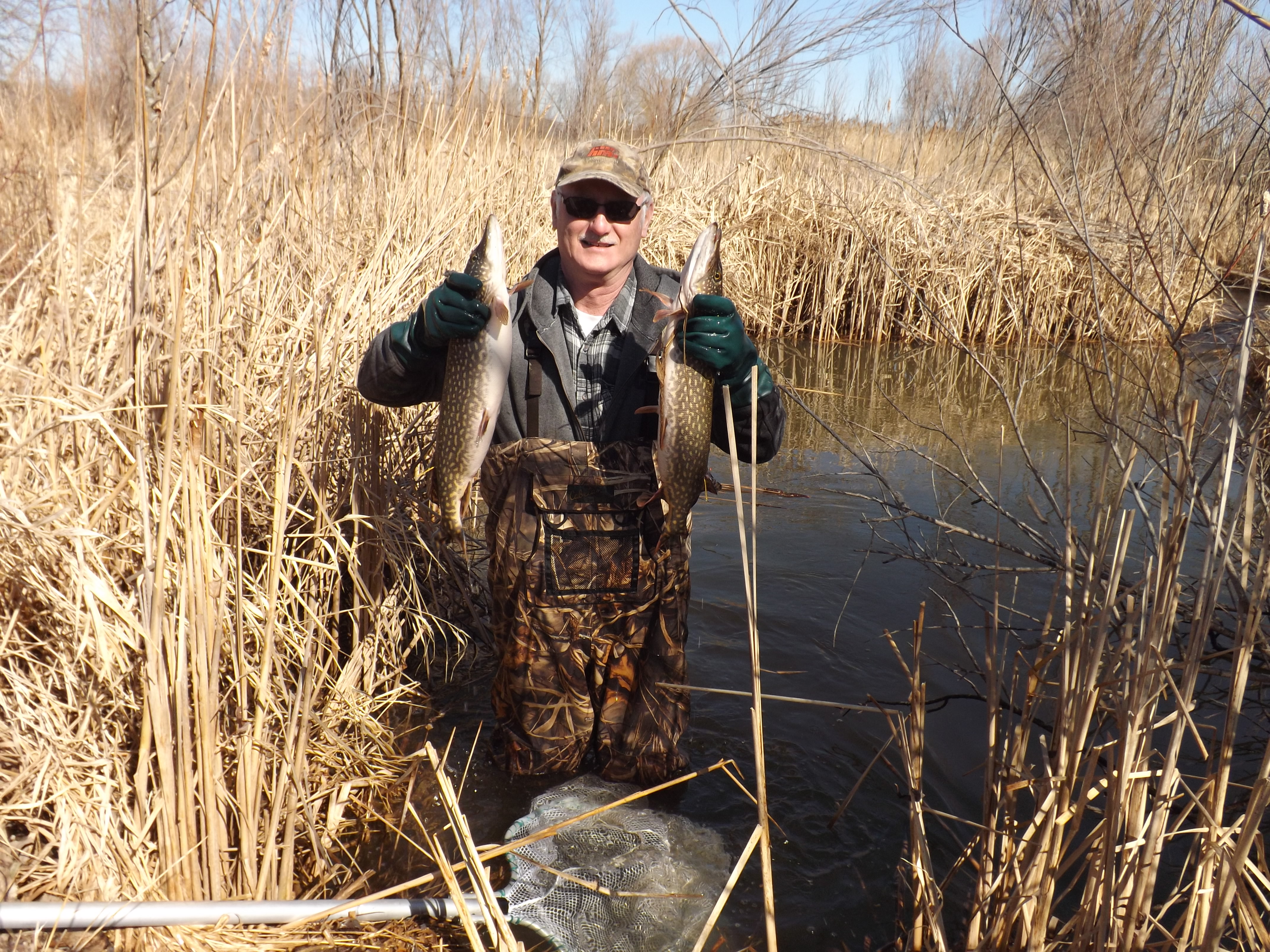Northern Pike are the second largest predator fish in the Bay of Green Bay. The Bay is a fertile estuary of Green Bay’s Fox River and an arm of Lake Michigan. Wisconsin Department of Natural Resource’s fishing creel surveys, netting results and other observations have noted the once robust Northern Pike population on Green Bay has fallen precipitously. Successful ‘early ice’ Northern Pike fishing on Green Bay has become only a fond memory. Walleyes have been a success story but the depleted Northern Pike population, along with the recovering but a still small population of Muskellunge, has led to an unbalanced predator/prey balance on the Bay, strongly tipped toward forage fish such as Gizzard Shad or White Perch.
Green Bay Northern Pike have evolved generally to leave the Bay each spring and attempt to spawn in inland wetlands. They sometimes travel tens of miles up flooded road ditches and small streams to reach a suitable wetland during March and April. Along the way they often encounter impediments to passage, such as dams or poorly positioned culverts. They are also vulnerable to natural and human predators. If the fish are able to pass through or over the obstacles, they may find that there are no suitable wetlands in which to congregate and spawn at the end of their journey.
In 2007, the Brown County Land and Water Conservation Department received a grant from the National Fish and Wildlife foundation to restore the Bay’s declining Northern Pike population. Then we received a four year grant from the U.S. EPA’s Great Lakes Restoration Initiative (GLRI) and additional funding from the Green Bay /Fox River Natural Resources Damage Assessment Trustee Council, U.S. Fish and Wildlife Service, Ducks Unlimited and other sources.
To begin our work, we found surprisingly little research on Green Bay’s Northern Pike. We relied on past work from Dick Rost– retired Wisconsin Department of Natural Resources fish technician and others to form specifics of our restoration plan.
We set two goals:
- To find and remove impediments to fish migration in streams and road ditches leading from the Bay to potential spawning wetlands on Green Bay’s West Shore.
- To restore wetland destinations that have become degraded and lost the ability to provide suitable spawning habitat.
Since 2007, we had completed 50 wetland restorations or impediment removals on streams and road ditches on Green Bay’s west shore, primarily in the Village of Suamico and Town of Pittsfield. We’ve found that completed wetland restorations benefit many species of amphibians, waterfowl, reptiles and other fish species. They either live in the restored habitat or use it to reproduce.
But Northern Pike spawning success in some of our early projects had been disappointing. The flat topography of the area leads to flashiness or quick rises and falls in stream and ditch water flow. That can strand adult fish or dry out developing eggs and young fry. But we continued and learned some valuable lessons. Many fish spawning events are chancy at best so we learned to try to mimic a natural wetland that maintains a flat gentle flow throughout the spawning and egg development time period. Sometimes that condition requires a water control structure that holds the falling water levels just a little bit longer to save the developing eggs, especially during a low precipitation spring.
With that knowledge and experience we began producing some restorations that have been widely successful! On one site off of Brown Road in Suamico, we trapped 10,500 Northern Pike fry in 2013 leaving the wetland and continuing to the ditch to begin their journey to the Bay. Many other sites have shown impressive success rates.
In 2015, we decided to expand our efforts. We believe there might be an untapped spawning potential on tributaries of the Green Bay’s Fox and East Rivers. But many of these waterways are small and turbid. Their watersheds originate in areas of heavy soils and suffer from agricultural and residential non-point pollution. We use fyke nets to locate the adults and fry traps to locate young of the year Northern Pike in the small streams.
To date, we have recorded exciting results in a few of the urban creeks! Some have shown impressive numbers of adult Northern Pike using the waterway for their spring spawning migration. After one season of young of the year trapping though, we have yet to show much for spawning results.
Continued research should allow us to narrow down some of the problems Northern Pike are encountering in these watersheds. We will then develop plans to correct some of those problems. The need to provide spawning habitat continues. “The accomplishments of Brown County Land and Water Conservation Department and other partners such as Oconto County LWCD, Ducks Unlimited, The Nature Conservancy, Oneida Tribe, and University of Wisconsin (Green Bay and Madison) over the last several years will continue to benefit Northern Pike and other wetland-associated species for many decades to come, and ultimately make the area a better place to live and recreate in,” said Tammie Paoli – WI DNR Green Bay Fisheries Biologist.
Submitted by: Charles Larscheid
Manager – West Shore Northern Pike Habitat Restoration Project
Brown County Land and Water Conservation Department

